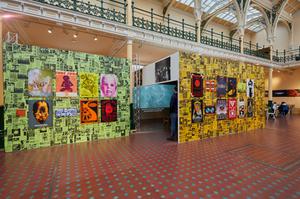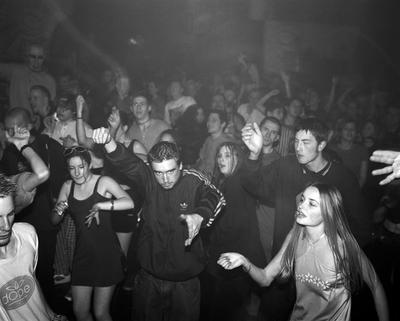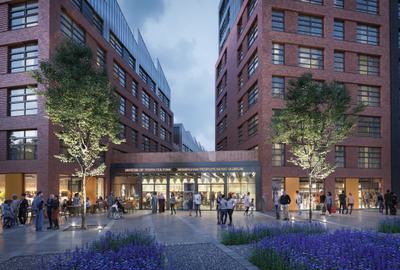News Story
Jez Collins, the founder of Birmingham Music Archive (BMA), is changing people’s perception and understanding of Birmingham as a music city one project at a time. And there are many, running simultaneously, and all seemingly culminating in the development of a new Birmingham Music Museum set to open in Digbeth in 2025/26.
The current In the Que exhibition at Birmingham Museum and Art Gallery (BMAG) celebrates the Que Club, a prominent nightclub and music venue housed in the Grade II* listed Methodist Central Hall (completed in 1904). The Que Club operated from 1991 - 2002 (during the height of the dance music movement in the UK) and again from 2007 – 2017 until its permanent closure. The exhibition is the epitome of Collins’ passion and tenacity for chronicling the city’s music scene.
However, it hasn’t been straightforward, with potential funders initially wondering why a nightclub exhibition was worthy to be deemed culture and heritage, and various venues, including the Central Hall (under new ownership at the time), pulling out of hosting the exhibition for a number of reasons including financial difficulties and Covid restrictions.
In the Que is one of two exhibitions the music enthusiast and academic is currently showcasing with the other, Ceremony: Pop Comes to Campus focusing on the hundreds of concerts staged at the University of Birmingham, including Joy Division’s last live gig.
On Record - Birmingham 2022 Festival
Collins has also orchestrated the On Record project – part of the Commonwealth Games Birmingham 2022 Festival – which has combined In Conversation, 22 live discussions and performances by Brummie musicians and people involved in the music industry over the spring and summer at Symphony Hall. The conversations have been recorded and distributed as podcasts which can be listened back to. On Record is a multi-artist, multi-genre sonic love letter to Birmingham featuring 11 new and original songs about the city and can be heard across streaming platforms via this link https://ingrv.es/on-record-ug4-n
The latter includes UB40’s song Champion featuring Dapz on the Map and Gilly G, which was chosen as the official Commonwealth Games 2022 song and Friendly Fire Band’s, It’s a Brum Ting song, which was heard throughout the BBC’s programming of the Games.
Last year he was also behind the installation of 30 wooden heritage maps at rail stations across Birmingham, pinpointing the musical talent emanating from those areas. The maps were designed by Space:Play and feature Spotify QR Codes which link to the music of each area. The project was funded by West Midlands Railway and built on the earlier For-Wards project created by Bobbie-Jane Gardner and Claire Hartley.
Not only that but Collins is working with a property developer to create a new Birmingham Music Museum in Digbeth as part of a £250m mixed-use development.
All of these projects come under the umbrella of BMA, which was established in 2008 by Collins as a website that grew into a community of thousands of music-lovers, sharing music stories, photos and objects celebrating the Birmingham Music scene from the 1950s onwards.
Birmingham’s rich music history
“The Birmingham Music Archive is a creative and cultural arts organisation that preserves, celebrates and documents Birmingham’s rich music history, heritage and culture,” says Collins.
Part of this recent uplift in projects has resulted in Collins going full-time with the organisation in 2018 and part of it has been through the groundwork laid down the decade before but all of it points to his dogged determination to promote the city’s music scene.
Through BMA Collins has built up a 15,000 following as part of the online resource and social media platforms, gone on to study and work at Birmingham City university co-authored reports for organisations such as Arts Council England, met with property developers over many years to open up opportunities for heritage projects (finally getting some success with the Birmingham Music Museum) and more recently receiving funding to develop music exhibitions and projects.
In The Que
This perseverance has been embodied in many ways by the In The Que exhibition, which opened at BMAG in April but was beset by funding challenges and Covid delays from its conception in 2018.
“The Que Club project came about because someone put me in touch with Matt Ford who worked there and he wanted to do a project,” says Collins who had been unsuccessful twice before with National Lottery Heritage Fund bids for projects, including one focusing on the history of black music in Birmingham.
“So, I thought we had a chance with this and I said I would write a bid to the National Lottery Heritage Fund.”
Earlier that year the Central Hall had been bought by new owners and Collins got in touch with them to explain about its recent history as a nightclub and they offered him a unit in the building to create his exhibition.
“We put the application in and it was rejected. They said they didn’t think it was heritage or people wouldn’t see it as heritage. I was really annoyed.”
But Collins’s plans and frustration didn’t stop there. In September 2018 he watched a BBC documentary: Can You Feel It – How Dance Music Took Over The World, which told of the global rise of house and techno music.
Collins was infuriated because it didn’t mention how Birmingham-born Neil Rushden, a DJ and entrepreneur, went to Detroit and was introduced to one of the originators of techno, Kevin Saunderson who gave him a cassette of his music. This would result in Rushden and Derrick May compiling the album Techno the New Dance Sound of Detroit (including Inner City’s Big Fun) introducing and naming Techno as a genre for the first time in the UK.
Our history
“Neil brought it into Birmingham first and then it went to Berlin and other places. And the Birmingham Music Archive page, which had about 3,500 followers at the time, blew up. Hundreds of people were asking: ‘Why does Birmingham always miss out?’ ‘Why don’t they talk about our history?’ It was outrageous because techno came from Detroit and into Europe through Birmingham.”
However, this public reaction was to be fortuitous for the In the Que project as it demonstrated the passion for music in the city and yearning for recognition of its accomplishments.
Collins took screen shots of the comments and rewrote part of his application and a year later, in the autumn of 2019, was successful with funding.
“It was through that perseverance that we got the funding and because I refused to accept this was not an important part of our cultural heritage.”
At the same time the property firm who’d planned to transform the Central Hall went into liquidation, which meant that he had to find a new venue. The exhibition was now to be held at the Medicine Bakery and Gallery on New Street in May 2020 whose owner, Simon Jones had DJ’ed at the Que Club.
But because of Covid it was cancelled five times during 2021 and the Medicine Bakery and Gallery had to pull out to complete planned renovations.
“I was absolutely gutted and the heritage fund were beginning to ask questions, too,” says Collins.
Not giving up, the exhibition was to be relocated to another venue under the railway arches in Digbeth only for it to be double booked.
Meeting with BMAG
That’s when in September 2021 Collins met with Rebecca Bridgman, Curatorial Team Leader at Birmingham Museums Trust about collections and his work to create a new music museum.
“So, while I was there, I pitched this readymade exhibition made by and about people from the city and further afield, and their connection to the Que Club.”
He then had to write a business case to be seen by the committees and signed off by the directors. In the Que was then programmed to be part of the partial reopening of BMAG in April 2022 along with four other exhibitions by Birmingham creative organisations and artists.
Now the full-scale exhibition is on a seven-month run in the museum’s Industrial Galleries complete with personal artefacts, photographs, flyers and posters as well as a 35-minute film (filmed by Matt Ford – Pretty Hate Productions) with Collins conducting the interviews with former DJs, managers and staff.


Donovan photographs
Through one of the interviews for the film – with Chris Wishart founder of the House of God event at the club – Collins came across a collection of photographs taken at the Que Clue by Terence Donovan, the world-renowned photographer who in the 1960s had become famous for his portraits of Jimi Hendrix and Twiggy.
In 1996 his son Terence Jr who Dj’d at House of God asked his dad to come and take some photographs, which he gladly did and it was one of his last photography projects.
“It gave the exhibition an international focus with one of the world’s great photographers and it uncovered previously unseen photographs.”

Incredible response
Initially the exhibition was to run for three weeks and be seen by a few thousand but because of its location within BMAG it could be seen by upwards of 100,000 – the museum’s opening weekend saw 5,000 visitors.
“I’m so proud of the exhibition. It was critical for the people who have supported us and trusted us with their personal items. We had to do it for them. It’s turned out way beyond my wildest dreams, the response from the museum and visitors has been incredible.”
Collins says that people taking photos with the flyers and the photographs and having travelled from places such as the Shetland Isles to see themselves and friends portrayed in the exhibition, literally in the photos, has been overwhelming.
“That connection is key. And it’s amazing to be part of the museum’s partial reopening and set up, which is helping massively with the planning for the new museum.
“Working with the curators and designers and the whole museum team has been fantastic. It has strengthened the relationship and we are already talking about the next project and how we can have a more formal relationship between the Birmingham Music Museum and the archive and BMAG.”
Birmingham Music Museum
The Birmingham Music Museum has been the result of, as Collins puts it, ‘sticking my nose in places where probably it wasn’t wanted’, particularly around planning in the city.
Through a myriad of projects from Broad Street’s MODA to HS2, Collins pushed the case for the culture of those sites to be recognised in some way, often with limited success.
Although along the way he made important contacts, which led to an introduction to property developer Cole Waterhouse who were planning to develop Upper Trinity Street in Digbeth.
Collins met with Cole Waterhouse in September 2019 and they were really interested in the Birmingham Music Archive and asked him what his long-term aim was. “And I said: ‘A music museum’. And that was the first time I’d spoken about it.”
The upshot of this was that they contracted Collins as their Cultural Lead and he wrote their cultural and place-making strategy. That involved him introducing them to artists, painters, ceramicists, cultural organisations including the National Trust, BMAG and the Museum of Youth Culture.
“I knew that the Museum of Youth Culture was looking for a new permanent home, so I thought ‘why don’t we speak to them and see whether they would be prepared to relocate from London to Birmingham’.”
After a year of negotiations this led to the Birmingham Music Museum and the Museum of Youth Culture being allocated a space of 7,500 sq ft with a 50% rent reduction in perpetuity.

Headquarters for the Museum of Youth Culture
Birmingham will eventually be the new headquarters for the Museum of Youth Culture and they also plan to open a third site in Glasgow.
“So, that made it financially viable and also there are a lot of links between youth culture and music.
“The vision for the museum is that it is, like the archive now, made up of materials that are very important to individuals. I want someone when they walk in, whether they are from Birmingham, around the UK, or abroad, they see themselves reflected on the walls or they see someone who looks like them, lives like them and works like them.
“That will enable us to create a community space. I want people to feel that they can contribute to it, come in, and regardless of who they are and what they do, feel that they are some way represented through what they see on the walls.
“Whether they are from Hodge Hill or Houston, they can come in and see the super diverse communities of the city, how the city has developed and how music has influenced the city and how the city has influenced music.”
Collins says there is a great appetite for a music museum and it may be that at some point they need more space. “I think it will grow – there is so much history in the city, so much diversity and different music genres. We go back to music halls, the germs of popular music primarily post 1950s with the birth of rock ‘n’ roll and jazz for example, all this was happening in Birmingham at the time and we want to tell and celebrate those stories.”
The next step is to seek funding for a feasibility study and evolve revenue streams.
Planning permission for the Upper Trinity Street development was granted in the summer of 2021. Cole Waterhouse say the aim is to be on site at the beginning of 2023 to start phase one and the second phase, where the museums are being built, will be completed by 2025 to 2026.
The new museum is a huge project for Collins and the city but it’s not all he’s concentrating on.
He’s back working with Cole Waterhouse on a scheme in Leeds, with MODA on their Great Charles Street development, Irish developer Press Up, who are redeveloping the Methodist Central Hall into a live music venue, hotel, food and drink establishments. Plans include the restoration of the auditorium, cocktail bars and roof terraces and a couple of other exciting projects that are coming forward.
Reopening of Que Club
“The Que Club is going to be reopening. There will be a music venue back in the Central Hall – 1,300 capacity – sadly I don’t think they will be having raves in there but you never know! They will keep features such as the organ, which is beyond repair and keeping the stage and put seating back in.”
Collins is also continuing to try and save The Crown pub on Station Street, where Earth, the forerunner to Black Sabbath, played their first gig and turn it into a tourist attraction.
“It’s a passion and a labour of love and I really believe there is a real cultural value in what I’m doing.
“I want this region to be known for its music. The talent is outrageous, and we do not support it enough. It brings in jobs, it supports jobs, it brings in tourists, it helps social cohesion and wellbeing our cultural offer.”
In the Que runs until 30 October at BMAG and the On Record album can be streamed online.